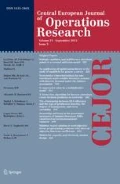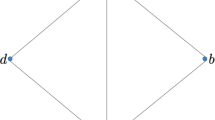Abstract
In this paper we treat the r-interdiction covering problem with fortification (RICF). The environment of this problem is composed of a set of customers J and a set of facilities I. For each customer j, there is set of facilities containing the facilities that can cover the demand of j. The system efficiency is given by the sum of the total covered demand. The facilities are subject to interdictions. When a facility is interdicted, it can not cover the demand of any customer. To mitigate the negative impact of the interdictions on the system efficiency, the system planner can fortify a subset of facilities. If a facility is fortified then it can not be interdicted. The RICF consists of choosing q facilities to be fortified knowing that r not fortified facilities will be interdicted at the worst case. We propose a branch-and-cut algorithm for the problem. Our results are compared with the exact method found in the literature, being faster for the most instances, mainly the large ones.







Similar content being viewed by others
References
Alderson DL, Brown GG, Carlyle WM (2014) Assessing and improving operational resilience of critical infrastructures and other systems. In: Bridging Data and Decisions. Informs, pp 180–215
Altner DS, Ergun Ö, Uhan NA (2010) The maximum flow network interdiction problem: valid inequalities, integrality gaps, and approximability. Oper Res Lett 38(1):33–38
Berman O, Drezner T, Drezner Z, Wesolowsky G (2009) A defensive maximal covering problem on a network. Int Trans Oper Res 16(1):69–86
Brown G, Carlyle M, Salmerón J, Wood K (2006) Defending critical infrastructure. Interfaces 36(6):530–544
Choi Y, Suzuki T (2013) Protection strategies for critical retail facilities: applying interdiction median and maximal covering problems with fortification. J Oper Res Soc Japan 56(1):38–55
Church RL, Scaparra MP (2007) Protecting critical assets: the r-interdiction median problem with fortification. Geogr Anal 39(2):129–146
Church RL, Scaparra MP, Middleton RS (2004) Identifying critical infrastructure: the median and covering facility interdiction problems. Ann Assoc Am Geogr 94(3):491–502
Dong L, Xu-Chen L, Xiang-Tao Y, Fei W (2010) A model for allocating protection resources in military logistics distribution system based on maximal covering problem. In: 2010 international conference on logistics systems and intelligent management, vol 1. IEEE, pp 98–101
Fischetti M, Ljubic I, Monaci M, Sinnl M (2016) Interdiction games and monotonicity. Tech rep
Israeli E, Wood RK (2002) Shortest-path network interdiction. Networks 40(2):97–111
Keçici S, Aras N, Verter V (2012) Incorporating the threat of terrorist attacks in the design of public service facility networks. Optim Lett 6(6):1101–1121
Lei TL (2013) Identifying critical facilities in hub-and-spoke networks: a hub interdiction median problem. Geogr Anal 45(2):105–122
Nandi AK, Medal HR, Vadlamani S (2016) Interdicting attack graphs to protect organizations from cyber attacks: a bi-level defender-attacker model. Comput Oper Res 75:118–131
O’Hanley JR, Church RL (2011) Designing robust coverage networks to hedge against worst-case facility losses. Eur J Oper Res 209(1):23–36
O’Hanley JR, Church RL, Gilless JK (2007a) The importance of in situ site loss in nature reserve selection: balancing notions of complementarity and robustness. Biol Conserv 135(2):170–180
O’Hanley JR, Church RL, Gilless JK (2007b) Locating and protecting critical reserve sites to minimize expected and worst-case losses. Biol Conserv 134(1):130–141
Pereira MA, Coelho LC, Lorena LA, de Souza LC (2015) A hybrid method for the probabilistic maximal covering locationallocation problem. Comput Oper Res 57:51–59
Pessoa AA, Poss M, Roboredo MC, Aizemberg L (2013) Solving bilevel combinatorial optimization as bilinear min–max optimization via a branch-and-cut algorithm. Ann XLV Braz Symp Oper Res 2:2497–2508
Roboredo MC, Pessoa AA (2013) A branch-and-cut algorithm for the discrete (r/p)-centroid problem. Eur J Oper Res 224(1):101–109
Sarhadi H, Tulett DM, Verma M (2015) A defender-attacker-defender approach to the optimal fortification of a rail intermodal terminal network. J Transp Secur 8(1–2):17–32
Scaparra MP, Church RL (2008a) A bilevel mixed-integer program for critical infrastructure protection planning. Comput Oper Res 35(6):1905–1923
Scaparra MP, Church RL (2008b) An exact solution approach for the interdiction median problem with fortification. Eur J Oper Res 189(1):76–92
Snyder LV, Atan Z, Peng P, Rong Y, Schmitt AJ, Sinsoysal B (2016) Or/ms models for supply chain disruptions: a review. IIE Trans 48(2):89–109
Yuan W, Zhao L, Zeng B (2014) Optimal power grid protection through a defender-attacker-defender model. Reliab Eng Syst Saf 121:83–89
Author information
Authors and Affiliations
Corresponding author
Rights and permissions
About this article
Cite this article
Roboredo, M.C., Aizemberg, L. & Pessoa, A.A. An exact approach for the r-interdiction covering problem with fortification. Cent Eur J Oper Res 27, 111–131 (2019). https://doi.org/10.1007/s10100-017-0494-7
Published:
Issue Date:
DOI: https://doi.org/10.1007/s10100-017-0494-7




